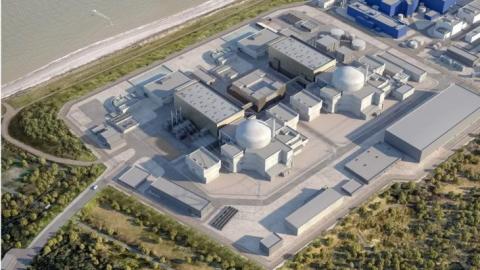UK's biggest expansion of nuclear power for 70 years
In the UK's new energy roadmap, it sets out how the UK will increase nuclear generation by up to 4 times to 24GW by 2050, creating new jobs, reducing bills and strengthening Britain’s energy security.
In the 2 years since Putin’s illegal invasion of Ukraine, the government has doubled down on security of supply to protect the country from price volatility and hostile foreign regimes and bolster the UK’s energy independence.
- Government roadmap includes exploring a new power station as big as Hinkley C and Sizewell C
- UK becomes first country in Europe to launch high-tech nuclear fuel programme with up to £300 million investment into UK production, pushing Putin out of global market
- Measures such as smarter regulation will help quadruple UK nuclear power by 2050 up to 24GW – the biggest expansion for 70 years
- The government today outlines plans for the biggest expansion of nuclear power for 70 years to reduce electricity bills, support thousands of jobs and improve UK energy security – including exploring building a major new power station and investing in advanced nuclear fuel production.
The Civil Nuclear Roadmap will give industry certainty of the future direction of the UK’s ambitious nuclear programme, on top of the government’s historic commitment to Sizewell C and world-leading competition to develop small modular reactor (SMR) technology.
The roadmap sets out how the UK will increase generation of this homegrown supply of clean, reliable, and abundant energy by up to 4 times to 24 gigawatts (GW) by 2050 – enough to provide a quarter of the UK’s electricity needs.
The plans include next steps for exploring a GW-scale power plant as big as Sizewell in Suffolk or Hinkley in Somerset, which are capable of powering 6 million homes each.
The government will also invest up to £300 million in UK production of the fuel required to power high-tech new nuclear reactors, known as HALEU, currently only commercially produced in Russia.
As the first country in Europe to launch a HALEU programme, the UK will lead the way from its North West production hub to provide the world with this form of uranium fuel, with the first plant aiming to be operational early in the next decade. This builds on the ambition to return uranium conversion to the Springfields nuclear fuel site, both of which are critical to pushing Putin out of the global market.
An additional £10 million will be provided to develop the skills and sites needed to produce other advanced nuclear fuels in the UK, helping to secure long term domestic nuclear fuel supply and support our allies.
The roadmap also includes a government ambition to secure 3 – 7GW worth of investment decisions every 5 years from 2030 to 2044 on new nuclear projects.
Plans to streamline the development of new power stations and introduce smarter regulation could speed up the overall process and, as a result, the delivery of nuclear power in the UK. This includes allowing regulators to assess projects while designs are finalised, and better join-up with overseas regulators assessing the same technology.
Ministers will bring together the brightest and best from the nuclear industry and beyond as part of a ‘hackathon’ event to come up with ideas on how government and industry can accelerate new nuclear projects, while maintaining the highest levels of safety and security.
These plans will help build new supplies of affordable and clean domestic power so the transition to net zero doesn’t mean higher prices, protecting households from global instability.
The government is also today publishing 2 consultations, one on a new approach to siting future nuclear power stations and another on supporting the sector and encouraging private investment to roll out advanced nuclear projects. The proposals will attract investment in the UK nuclear sector by empowering developers to find suitable sites rather than focusing on 8 designated by government. Community engagement will remain critical to any decisions, alongside maintaining robust criteria such as nearby population densities.
Following its launch last year, Great British Nuclear (GBN) will drive the UK’s nuclear ambitions forward, including through the game-changing SMR competition which will soon invite short-listed companies to tender.
Unlike conventional nuclear reactors that are built on site, SMRs are smaller, can be made in factories, and could transform how power stations are built by making construction faster and less expensive. Alongside large gigawatt power stations, SMRs will play a key role in delivering on the expansion of UK nuclear capacity.
As well as powering homes, innovations in the nuclear sector could provide direct heat for industry, energy for green hydrogen production, and medical isotopes for the diagnosis and treatment of cancer.
Analysis by the Nuclear Skills Strategy Group suggests that to reach up to 24GW, the civil and defence nuclear workforce will need to double over the next 20 years – supporting around 80,000 additional skilled jobs across the UK.
The Nuclear Skills Taskforce will shortly set out plans to meet the demand of an industry - already worth £6 billion to the British economy - which is likely to include increasing the numbers of graduates and apprentices and attracting mid-careerists with relevant skills and expertise.
In 1956, the UK established the world's first civil nuclear programme with the opening of Calder Hall at Windscale and was dominate by the domestically developed Magnox and its successor AGR reactors with graphite moderator and CO2 coolant.
At the peak in 1997, 26% of the nation's electricity was generated from nuclear power. Since then several reactors have closed and by 2012 the share had declined to 19%.
The older AGR reactors have been life-extended, but they are now towards the end of their life and are undergoing a large scale decommissioning programme run by the NDA Group.
EDF Energy owns and manages the five currently operating and two de-fuelling reactor sites.
Four new plants are proposed to be built in the next few decades. All nuclear installations in the UK are overseen by the Office for Nuclear Regulation.
Rolls-Royce is preparing a small modular reactor (SMR) design called the Rolls-Royce SMR, a close-coupled four-loop PWR design. Power output is 470 MWe which is above the usual range considered to be a SMR.
GE-Hitachi’s BWRX-300 was announced in April 2023 as one of the competitors to the Rolls-Royce SMR. However the full remit of Great British Nuclear, which was announced by the Boris Johnson government in 2022, still needs to be decided by the Rishi Sunak government including its budget and if eventually it will be a nuclear plant operator.
In July 2023, Energy Secretary Grant Shapps said he was launching an international competition to select up to four different SMR technologies "to go through to the final design stage", supported by up to £157 million of funding. He said the final investment decision will be taken by the next parliament, and UK SMRs might start operating by the 2030s.
Six technologies were selected for consideration, EDF NUWARD, GE Hitachi BWRX-300, Holtec International SMR-160+, NuScale Power, Rolls-Royce SMR and the Westinghouse AP300.







